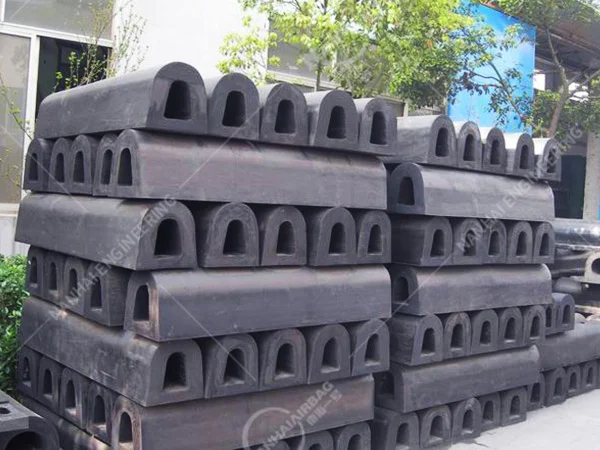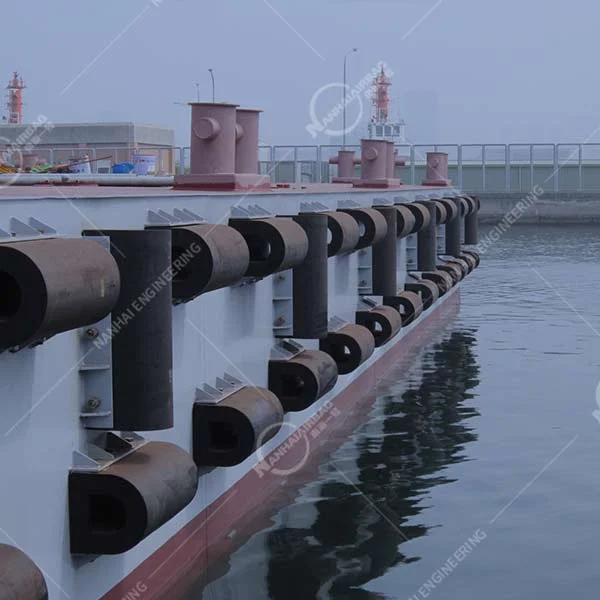Pneumatic Rubber Fenders: The “Soft Power” Guardians of Safe Docking (No More Scratched Hulls!)
04/09/2025Foam Fenders: The Soft, Smart Way to Keep Your Boat Scratch-Free (No More Docking Woes!)
11/09/2025

Imagine this: You’re guiding your 30-foot sailboat into a busy marina on a windy afternoon. A sudden gust pushes the bow—you adjust the wheel, but thud—the hull slams into the dock’s metal cleat. Paint flakes, gelcoat cracks, and now you’re facing a $800 repair bill. For boat owners, marina operators, and anyone who’s ever docking a vessel, these moments are stressful… and costly. That’s where D rubber fenders step in: the unassuming, D-shaped heroes of marine protection, designed to turn chaotic docking into smooth, scratch-free routines. Let’s break down why these rubber workhorses are a must-have for any waterfront setup.
What Is a D Rubber Fender? (The Simple, Googly Answer)
A D rubber fender is a durable, D-shaped marine fender made from high-quality rubber (often EPDM or natural rubber) that absorbs impact energy during docking, protecting boats, docks, and other vessels from scratches, dents, or structural damage. Its unique D-shape—curved on one side, flat on the other—lets it contour to uneven hulls, distribute force evenly, and “cradle” boats gently, even in rough water. Think of it as a shock-absorbing pillow for your boat’s hull, built tough to handle the wear and tear of daily docking.
Why This Matters: When a “Basic” Fender Costs You More Than Money
Docking mishaps aren’t just annoying—they’re financial drains. A single hard hit can crack a hull, tear gelcoat, or damage expensive boat components. And it’s not just yourwallet taking a hit: Marinas lose customers when “rough docking” becomes their reputation.
Take Captain Jake, a New England lobster boat operator. For years, his dock used rigid static fenders. During peak season, 40% of his clients reported hull damage after docking—scratches that required $500+ in repairs. “Boaters kept complaining,” he says. “Some even switched to competing marinas. My reputation was tanking, and I was bleeding cash.”
Jake switched to D rubber fenders. Within a year, hull damage complaints dropped by 90%. “The fenders conform to the boat’s shape, so they don’t bash into sharp edges,” he explains. “Now, my customers call to say how easy docking is. My revenue’s up, and I’m spending less on repairs.”
This isn’t just a New England story. Here’s why D rubber fenders are urgent for youroperation:
- •Delicate Hulls Deserve Gentle Protection: Kayaks, sailboats, and fishing skiffs have thin, curved hulls. Rigid fenders (like steel or flat rubber) concentrate impact on one spot, causing dents or tears. D fenders’ curved design spreads force across a larger area, shielding even the most fragile hulls.
- •Marina Reputation = Repeat Business: Happy boaters return. Scratched hulls lead to angry reviews, lost customers, and wasted time fixing avoidable damage. D rubber fenders keep your marina’s Google rating high and your docks in demand.
- •Built to Last in Harsh Conditions: Saltwater, UV rays, and wave action degrade cheap fenders fast. D rubber fenders use weather-resistant materials (like EPDM) that hold up for 5–7+ years with minimal upkeep—saving you money long-term.
How Do D Rubber Fenders Work? The Science of “Docking Without Drama”
These aren’t your average pool toys—they’re engineered for marine chaos. Here’s what makes them tick:
1. D-Shape = Perfect Contouring
The D-shape is no accident. The curved side hugs the boat’s hull, while the flat side anchors to the dock. This design eliminates sharp pressure points, ensuring the fender conforms to anyhull shape—curved, angled, or barnacle-covered.
2. Rubber = Shock Absorption Superpower
D rubber fenders are made from tough, flexible rubber (EPDM or natural rubber). When a boat hits the fender, the rubber compresses, slowing the impact and converting kinetic energy into heat. This “shock absorption” reduces peak force by up to 50% compared to rigid fenders—so your hull stays scratch-free.
3. Low Effort, High Impact
No heavy tools needed. Most D rubber fenders weigh 3–8 pounds and come with pre-installed valves for quick inflation (a hand pump or small compressor works). A team of 1–2 people can set up a full marina’s worth in under an hour—perfect for seasonal docks, fishing tournaments, or temporary setups.
D Rubber Fenders vs. the Competition: Why They’re in a League of Their Own
Not all fenders are created equal. Here’s how D rubber fenders outshine their peers:
1. vs. Static Rubber Fenders
Static fenders are rigid and unyielding. They concentrate impact on small areas, leading to dents or tears. D rubber fenders? Their flexible, curved design “gives way” gently, spreading force across the hull.
2. vs. Marine Airbags
Marine airbags (inflatable rubber tubes) are great for liftingboats during launches or repairs. D rubber fenders, though, are for protectingduring docking. They don’t require cranes or heavy equipment—just inflate, place, and let the rubber do the work.
3. vs. Foam Fenders
Foam fenders are soft but lack structure. They compress too easily under heavy impact, offering little protection for large vessels. D rubber fenders combine foam’s shock absorption with rubber’s durability, making them ideal for small-to-large boats.
People Also Ask: Your Top D Rubber Fender Questions
Q: How do I choose the right size D rubber fender?
A: Measure your boat’s hull width at the waterline (most boats need 12–18 inches of coverage per side). For kayaks or small skiffs, 12–16 inches works. For 25–30-foot boats, 20–24 inches is ideal. Larger vessels (35+ feet) need 28–36-inch fenders.
Q: Are they easy to install?
A: Super easy. Most come with heavy-duty straps or brackets to secure them to docks. Inflate with a hand pump (included) or small compressor—no tools needed. Even a beginner can set one up in 5 minutes.
Q: Can they be used in both saltwater and freshwater?
A: Absolutely. D rubber fenders are made with non-toxic, corrosion-resistant materials (like EPDM), so they’re safe for lakes, rivers, and oceans. Rinse with fresh water monthly to remove salt or algae, and they’ll last for years.
Q: Are they worth the cost compared to cheaper fenders?
A: 100%. A 100Drubberfendermightcosttwiceasmuchasabasicrubberone,butitlasts3–4xlongerandslashesrepairbills.OnemarinainFloridasaved20,000/year after switching—enough to buy 200+ generic fenders.
Q: Do they come in different colors?
A: Yes—most suppliers offer black, gray, or custom colors to match your dock’s aesthetic.
Final Thoughts: Don’t Let Docking Disasters Sink Your Budget
Docking shouldn’t feel like a high-stakes game. With D rubber fenders, you’re not just buying a fender—you’re buying peace of mind. Peace of mind that your boat stays scratch-free, your marina keeps happy customers, and your wallet avoids unnecessary expenses.
Ready to upgrade? Start by measuring your boat and dock, then check out trusted marine suppliers (look for those specializing in marine fenders). Your hull, your dock, and your weekend plans will thank you—no more “thud” moments, just smooth, worry-free docking.
Keywords: marine airbags, marine fenders, rubber fenders
